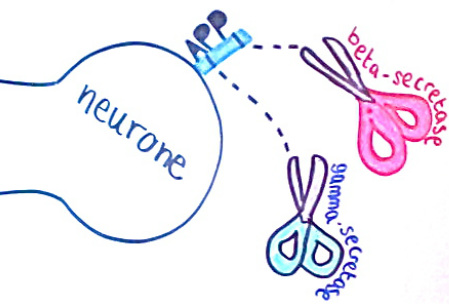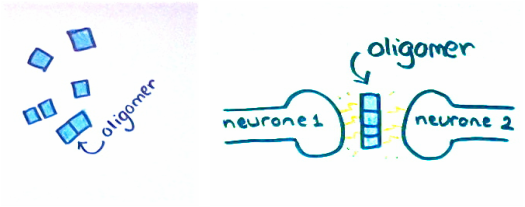
Before evaluating the various factors, it’s worth explaining how many scientists currently understand the disease is caused. Alzheimer’s itself is named after Dr Alois Alzheimer who in 1906 discovered abnormal deposits that had formed in the brain of a patient with dementia. These deposits have since been identified as extracellular amyloid beta plaques and intracellular tau tangles.
Amyloid plaques are clumps of the protein fragment amyloid beta from the protein APP which is found in synapses. Amyloid peptide is highly insoluble. It's thought that the amyloid beta fragments are ‘snipped’ by two enzymes (beta-secretase and gamma-secretase) and leave the synapses.
Amyloid plaques are clumps of the protein fragment amyloid beta from the protein APP which is found in synapses. Amyloid peptide is highly insoluble. It's thought that the amyloid beta fragments are ‘snipped’ by two enzymes (beta-secretase and gamma-secretase) and leave the synapses.

Once outside the synapses the fragments bind together to form oligomers.The oligomers can then enter the synapses and prevent neurotransmitters from reaching the post-synaptic neuron. This leads to synaptic failure and neuronal death. Loss of memory, one of the major symptoms of Alzheimer’s, is attributed to synaptic failure.
The oligomers can then bind together further to form plaques. It is understood that amyloid beta is produced naturally in the brain. However, over-production of the protein or decrease in its removal can lead to the formation of these oligomers.
Neurofibrillary tangles are fibres of the protein, tau. In Alzheimer’s sufferers there is an abnormally high level of tau within the nerve cells. The proteins accumulate to form tangles which prevent the nerve cell from receiving the essential nutrients.
The oligomers can then bind together further to form plaques. It is understood that amyloid beta is produced naturally in the brain. However, over-production of the protein or decrease in its removal can lead to the formation of these oligomers.
Neurofibrillary tangles are fibres of the protein, tau. In Alzheimer’s sufferers there is an abnormally high level of tau within the nerve cells. The proteins accumulate to form tangles which prevent the nerve cell from receiving the essential nutrients.

Changes also occur in the physical properties of the brain. As neurons die, tissue is lost and the brain shrinks. The shrinkage is most significant in the hippocampus, which is thought to be essential in the formation of new memories. Areas of the brain called ventricles also expand.
Both the presence of amyloid plaques and the presence of neurofibrillary tangles may cause the neurones of the cortex to die in vast numbers, which could account for the shrinkage of the brain that is characteristic of the disease. It is believed that genetic and environmental factors contribute to the formation of these deposits in Alzheimer’s disease. In developing a cure for Alzheimer’s, many scientists aim to find a way of preventing the formation of these deposits or aiding their removal.
But this is just one theory. There is much debate amongst scientists as to whether these deposits are the cause of Alzheimer’s or just the effect. More on that later…
References
Both the presence of amyloid plaques and the presence of neurofibrillary tangles may cause the neurones of the cortex to die in vast numbers, which could account for the shrinkage of the brain that is characteristic of the disease. It is believed that genetic and environmental factors contribute to the formation of these deposits in Alzheimer’s disease. In developing a cure for Alzheimer’s, many scientists aim to find a way of preventing the formation of these deposits or aiding their removal.
But this is just one theory. There is much debate amongst scientists as to whether these deposits are the cause of Alzheimer’s or just the effect. More on that later…
References
- Alzheimer’s Association, 2012. Alzheimer’s Disease Facts and Figures, Alzheimer’s & Dementia, [pdf] Volume 8, Issue 2. Available at: <http://www.alz.org/downloads/facts_figures_2012.pdf> [Accessed 12 July 2012]
- Alzheimer’s Association, 2012. Inside the Brain: An interactive tour [online] Available at: <https://www.alz.org/braintour/alzheimers_changes.asp> [Accessed 18 July 2012]
- HBO : Documentaries : The Alzheimer’s Project, 2012. The Connection between Insulin and Alzheimer’s [online video] Available at: <http://www.hbo.com/alzheimers/supplementary-the-connection-between-insulin-and-alzheimers.html> [Accessed 12 July 2012]
- Rose, S, 2003. The Making of Memory; From Molecules to Mind, Revised Edition, Great Britain : Vintage
- Diagram showing brain shrinkage in Alzheimer's Disease: www.ahaf.org

 RSS Feed
RSS Feed